Dani Lischinski
Story2Board: A Training-Free Approach for Expressive Storyboard Generation
Aug 13, 2025Abstract:We present Story2Board, a training-free framework for expressive storyboard generation from natural language. Existing methods narrowly focus on subject identity, overlooking key aspects of visual storytelling such as spatial composition, background evolution, and narrative pacing. To address this, we introduce a lightweight consistency framework composed of two components: Latent Panel Anchoring, which preserves a shared character reference across panels, and Reciprocal Attention Value Mixing, which softly blends visual features between token pairs with strong reciprocal attention. Together, these mechanisms enhance coherence without architectural changes or fine-tuning, enabling state-of-the-art diffusion models to generate visually diverse yet consistent storyboards. To structure generation, we use an off-the-shelf language model to convert free-form stories into grounded panel-level prompts. To evaluate, we propose the Rich Storyboard Benchmark, a suite of open-domain narratives designed to assess layout diversity and background-grounded storytelling, in addition to consistency. We also introduce a new Scene Diversity metric that quantifies spatial and pose variation across storyboards. Our qualitative and quantitative results, as well as a user study, show that Story2Board produces more dynamic, coherent, and narratively engaging storyboards than existing baselines.
EditInspector: A Benchmark for Evaluation of Text-Guided Image Edits
Jun 11, 2025Abstract:Text-guided image editing, fueled by recent advancements in generative AI, is becoming increasingly widespread. This trend highlights the need for a comprehensive framework to verify text-guided edits and assess their quality. To address this need, we introduce EditInspector, a novel benchmark for evaluation of text-guided image edits, based on human annotations collected using an extensive template for edit verification. We leverage EditInspector to evaluate the performance of state-of-the-art (SoTA) vision and language models in assessing edits across various dimensions, including accuracy, artifact detection, visual quality, seamless integration with the image scene, adherence to common sense, and the ability to describe edit-induced changes. Our findings indicate that current models struggle to evaluate edits comprehensively and frequently hallucinate when describing the changes. To address these challenges, we propose two novel methods that outperform SoTA models in both artifact detection and difference caption generation.
RefVNLI: Towards Scalable Evaluation of Subject-driven Text-to-image Generation
Apr 24, 2025Abstract:Subject-driven text-to-image (T2I) generation aims to produce images that align with a given textual description, while preserving the visual identity from a referenced subject image. Despite its broad downstream applicability -- ranging from enhanced personalization in image generation to consistent character representation in video rendering -- progress in this field is limited by the lack of reliable automatic evaluation. Existing methods either assess only one aspect of the task (i.e., textual alignment or subject preservation), misalign with human judgments, or rely on costly API-based evaluation. To address this, we introduce RefVNLI, a cost-effective metric that evaluates both textual alignment and subject preservation in a single prediction. Trained on a large-scale dataset derived from video-reasoning benchmarks and image perturbations, RefVNLI outperforms or matches existing baselines across multiple benchmarks and subject categories (e.g., \emph{Animal}, \emph{Object}), achieving up to 6.4-point gains in textual alignment and 8.5-point gains in subject consistency. It also excels with lesser-known concepts, aligning with human preferences at over 87\% accuracy.
Task-Specific Adaptation with Restricted Model Access
Feb 02, 2025

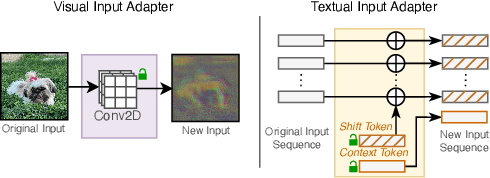
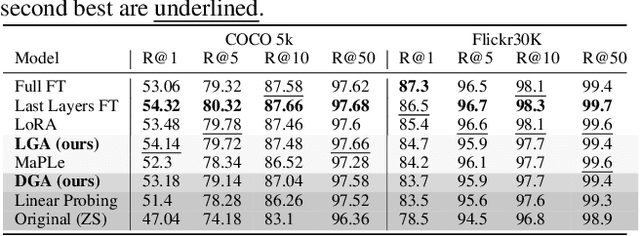
Abstract:The emergence of foundational models has greatly improved performance across various downstream tasks, with fine-tuning often yielding even better results. However, existing fine-tuning approaches typically require access to model weights and layers, leading to challenges such as managing multiple model copies or inference pipelines, inefficiencies in edge device optimization, and concerns over proprietary rights, privacy, and exposure to unsafe model variants. In this paper, we address these challenges by exploring "Gray-box" fine-tuning approaches, where the model's architecture and weights remain hidden, allowing only gradient propagation. We introduce a novel yet simple and effective framework that adapts to new tasks using two lightweight learnable modules at the model's input and output. Additionally, we present a less restrictive variant that offers more entry points into the model, balancing performance with model exposure. We evaluate our approaches across several backbones on benchmarks such as text-image alignment, text-video alignment, and sketch-image alignment. Results show that our Gray-box approaches are competitive with full-access fine-tuning methods, despite having limited access to the model.
Stable Flow: Vital Layers for Training-Free Image Editing
Nov 21, 2024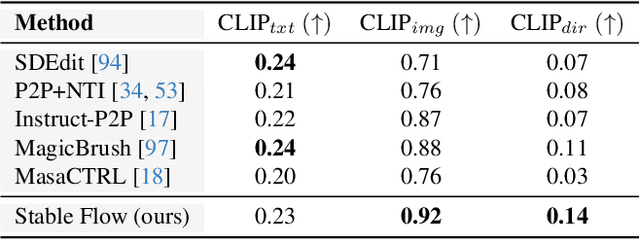
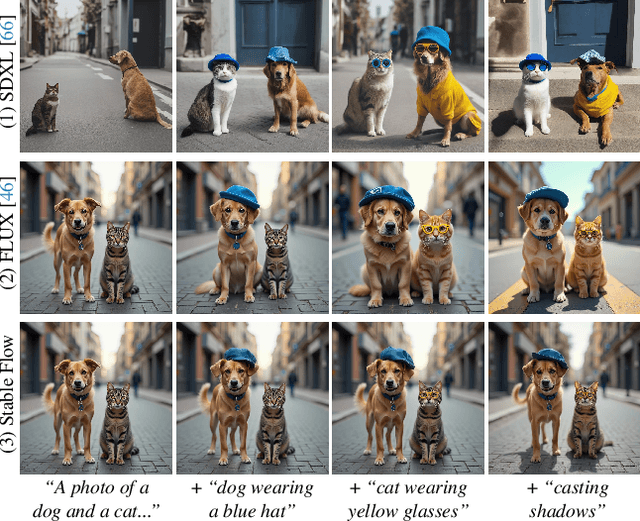

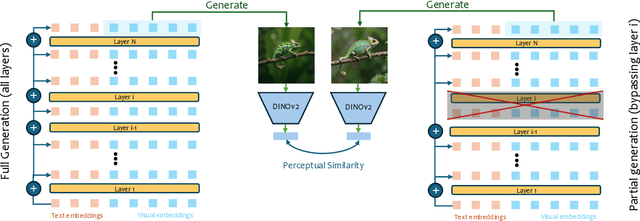
Abstract:Diffusion models have revolutionized the field of content synthesis and editing. Recent models have replaced the traditional UNet architecture with the Diffusion Transformer (DiT), and employed flow-matching for improved training and sampling. However, they exhibit limited generation diversity. In this work, we leverage this limitation to perform consistent image edits via selective injection of attention features. The main challenge is that, unlike the UNet-based models, DiT lacks a coarse-to-fine synthesis structure, making it unclear in which layers to perform the injection. Therefore, we propose an automatic method to identify "vital layers" within DiT, crucial for image formation, and demonstrate how these layers facilitate a range of controlled stable edits, from non-rigid modifications to object addition, using the same mechanism. Next, to enable real-image editing, we introduce an improved image inversion method for flow models. Finally, we evaluate our approach through qualitative and quantitative comparisons, along with a user study, and demonstrate its effectiveness across multiple applications. The project page is available at https://omriavrahami.com/stable-flow
Click2Mask: Local Editing with Dynamic Mask Generation
Sep 12, 2024



Abstract:Recent advancements in generative models have revolutionized image generation and editing, making these tasks accessible to non-experts. This paper focuses on local image editing, particularly the task of adding new content to a loosely specified area. Existing methods often require a precise mask or a detailed description of the location, which can be cumbersome and prone to errors. We propose Click2Mask, a novel approach that simplifies the local editing process by requiring only a single point of reference (in addition to the content description). A mask is dynamically grown around this point during a Blended Latent Diffusion (BLD) process, guided by a masked CLIP-based semantic loss. Click2Mask surpasses the limitations of segmentation-based and fine-tuning dependent methods, offering a more user-friendly and contextually accurate solution. Our experiments demonstrate that Click2Mask not only minimizes user effort but also delivers competitive or superior local image manipulation results compared to SoTA methods, according to both human judgement and automatic metrics. Key contributions include the simplification of user input, the ability to freely add objects unconstrained by existing segments, and the integration potential of our dynamic mask approach within other editing methods.
Seed-to-Seed: Image Translation in Diffusion Seed Space
Sep 01, 2024Abstract:We introduce Seed-to-Seed Translation (StS), a novel approach for Image-to-Image Translation using diffusion models (DMs), aimed at translations that require close adherence to the structure of the source image. In contrast to existing methods that modify images during the diffusion sampling process, we leverage the semantic information encoded within the space of inverted seeds of a pretrained DM, dubbed as the seed-space. We demonstrate that inverted seeds can be used for discriminative tasks, and can also be manipulated to achieve desired transformations in an unpaired image-to-image translation setting. Our method involves training an sts-GAN, an unpaired translation model between source and target seeds, based on CycleGAN. The final translated images are obtained by initiating the DM's sampling process from the translated seeds. A ControlNet is used to ensure the structural preservation of the input image. We demonstrate the effectiveness of our approach for the task of translating automotive scenes, showcasing superior performance compared to existing GAN-based and diffusion-based methods, as well as for several other unpaired image translation tasks. Our approach offers a fresh perspective on leveraging the semantic information encoded within the seed-space of pretrained DMs for effective image editing and manipulation.
DiffUHaul: A Training-Free Method for Object Dragging in Images
Jun 03, 2024



Abstract:Text-to-image diffusion models have proven effective for solving many image editing tasks. However, the seemingly straightforward task of seamlessly relocating objects within a scene remains surprisingly challenging. Existing methods addressing this problem often struggle to function reliably in real-world scenarios due to lacking spatial reasoning. In this work, we propose a training-free method, dubbed DiffUHaul, that harnesses the spatial understanding of a localized text-to-image model, for the object dragging task. Blindly manipulating layout inputs of the localized model tends to cause low editing performance due to the intrinsic entanglement of object representation in the model. To this end, we first apply attention masking in each denoising step to make the generation more disentangled across different objects and adopt the self-attention sharing mechanism to preserve the high-level object appearance. Furthermore, we propose a new diffusion anchoring technique: in the early denoising steps, we interpolate the attention features between source and target images to smoothly fuse new layouts with the original appearance; in the later denoising steps, we pass the localized features from the source images to the interpolated images to retain fine-grained object details. To adapt DiffUHaul to real-image editing, we apply a DDPM self-attention bucketing that can better reconstruct real images with the localized model. Finally, we introduce an automated evaluation pipeline for this task and showcase the efficacy of our method. Our results are reinforced through a user preference study.
EmoEdit: Evoking Emotions through Image Manipulation
May 21, 2024



Abstract:Affective Image Manipulation (AIM) seeks to modify user-provided images to evoke specific emotional responses. This task is inherently complex due to its twofold objective: significantly evoking the intended emotion, while preserving the original image composition. Existing AIM methods primarily adjust color and style, often failing to elicit precise and profound emotional shifts. Drawing on psychological insights, we extend AIM by incorporating content modifications to enhance emotional impact. We introduce EmoEdit, a novel two-stage framework comprising emotion attribution and image editing. In the emotion attribution stage, we leverage a Vision-Language Model (VLM) to create hierarchies of semantic factors that represent abstract emotions. In the image editing stage, the VLM identifies the most relevant factors for the provided image, and guides a generative editing model to perform affective modifications. A ranking technique that we developed selects the best edit, balancing between emotion fidelity and structure integrity. To validate EmoEdit, we assembled a dataset of 416 images, categorized into positive, negative, and neutral classes. Our method is evaluated both qualitatively and quantitatively, demonstrating superior performance compared to existing state-of-the-art techniques. Additionally, we showcase EmoEdit's potential in various manipulation tasks, including emotion-oriented and semantics-oriented editing.
Generating Non-Stationary Textures using Self-Rectification
Jan 05, 2024



Abstract:This paper addresses the challenge of example-based non-stationary texture synthesis. We introduce a novel twostep approach wherein users first modify a reference texture using standard image editing tools, yielding an initial rough target for the synthesis. Subsequently, our proposed method, termed "self-rectification", automatically refines this target into a coherent, seamless texture, while faithfully preserving the distinct visual characteristics of the reference exemplar. Our method leverages a pre-trained diffusion network, and uses self-attention mechanisms, to gradually align the synthesized texture with the reference, ensuring the retention of the structures in the provided target. Through experimental validation, our approach exhibits exceptional proficiency in handling non-stationary textures, demonstrating significant advancements in texture synthesis when compared to existing state-of-the-art techniques. Code is available at https://github.com/xiaorongjun000/Self-Rectification
 Add to Chrome
Add to Chrome Add to Firefox
Add to Firefox Add to Edge
Add to Edge